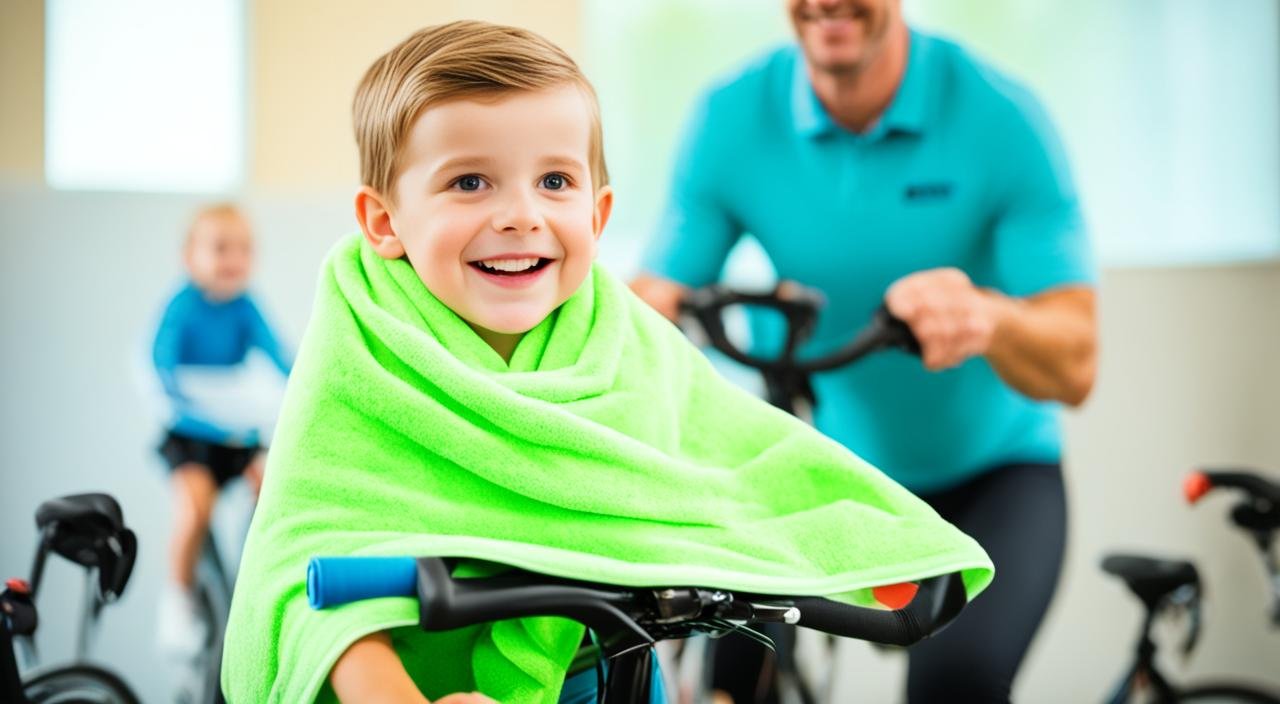Teaching a child to ride a bike is a thrilling and rewarding experience. But as a parent, you may wonder: What is the most effective method to teach my child how to ride a bike? Is there a way to make the learning process easier and more fun?
Well, get ready to revolutionize your approach with the towel method! Have you ever considered using a towel as a harness to help your child learn to ride a bike? It may sound unconventional, but this technique has proven to be highly effective in teaching kids bike riding skills.
In this article, we will guide you through the step-by-step process of teaching your child to ride a bike using the towel method. We’ll explore the benefits of this approach, provide helpful tips, and share other alternative methods for you to consider. By the end, you’ll have all the tools you need to confidently teach your child how to ride a bike.
Key Takeaways:
- The towel method is a simple and supportive technique to teach a child how to ride a bike.
- It involves using a towel as a harness to provide balance and support.
- The towel method helps children learn to balance, pedal, turn, and brake.
- It is an effective and fun method that can be used for children as young as 4 years old.
- By using the towel method, parents can actively participate in the teaching process and ensure a safer learning experience for their children.
The No Pedals Method
The no pedals method is another effective way to teach a child how to ride a bike. This method involves starting with a balance bike or a bike with the pedals removed. The child learns to balance and steer by scooting around with their feet on the ground. Once they are comfortable with basic balance, they can start coasting by lifting their feet off the ground. The next steps involve learning to turn while coasting, learning to pedal, and finally, learning to brake. This method helps the child develop essential bike riding skills in a progressive and fun way.
When using the no pedals method, the child begins by getting comfortable with the balance bike. This type of bike has no pedals and allows the child to focus solely on mastering the art of balancing. By using their feet to push themselves forward, they gradually build confidence and improve their coordination and control.
By starting with a balance bike, children can learn the fundamental skills of balance and steering without the added complexity of pedaling. This approach allows them to become familiar with the bike and build their confidence before transitioning to a pedal-driven bicycle.” – Cycling expert, Sarah Johnson.
Once the child has developed a strong sense of balance, they can progress to coasting. This involves lifting their feet off the ground and relying on their momentum to move forward. Coasting helps children learn the principles of gliding and understand how weight transfer and body positioning influence the bike’s movement.
Turning while coasting is the next step in the process. Children learn to lean their bodies and shift their weight to control the bike’s direction. As they gain confidence, they become more adept at making sharp and smooth turns, enhancing their overall bike riding skills.
After mastering coasting and turning, the child can move on to learning how to pedal. While it may take some time for them to get used to the motion, the previous experience with balancing and steering makes this transition easier. Encourage the child to start with short bursts of pedaling and gradually increase their speed and distance.
Finally, learning to brake completes the no pedals method. Teach the child how to use the brakes effectively, ensuring they understand how to slow down and bring the bike to a complete stop. Emphasize the importance of maintaining control and staying balanced while braking.
Benefits of the No Pedals Method
The no pedals method offers several benefits for teaching a child how to ride a bike:
- Improved Balance: By focusing on balancing without pedals from the beginning, children develop a strong sense of balance and stability.
- Enhanced Confidence: The progressive nature of this method allows children to gradually build confidence in their riding abilities.
- Develops Essential Skills: The no pedals method covers the foundational skills necessary for bike riding, including balancing, steering, and braking.
- Smooth Transition to Pedaling: With a solid foundation in balance and steering, children find it easier to transition to pedaling once they are ready.
- Fun and Engaging: A balance bike and the freedom of coasting provide a fun and exciting experience for children, making the learning process enjoyable.
The no pedals method allows children to develop the necessary skills for bike riding in a step-by-step and playful manner. By focusing on balance, steering, and gradually introducing pedaling and braking, children gain confidence and prepare themselves for independent cycling adventures.
The Grass Hill Method
The grass hill method is a great choice for teaching a child to ride a bike on a slope, specifically on a low-grade grass slope. This method utilizes the natural incline of the slope to allow the child to build momentum while the grass provides a cushioning effect and helps slow them down in case of a fall.
To teach a child using the grass hill method, start by finding a safe grass slope with plenty of open space to ensure a stress-free learning environment. Lower the bike seat so that the child’s feet can comfortably rest flat on the ground, providing a stable foundation.
Begin the learning process by teaching the child how to balance on the slope. Emphasize the importance of maintaining stability while coasting down the hill. As the child becomes more confident with balancing, gradually introduce them to steering, braking, and pedaling.
Encourage the child to learn at their own pace, allowing them to gain confidence in their ability to ride a bike. Provide positive reinforcement and support throughout the learning process. With the grass hill method, children can develop essential biking skills while enjoying the refreshing outdoors.
Benefits of the Towel Method

The towel method offers several benefits for teaching a child how to ride a bike. This technique not only ensures a fast learning process but also helps in improving balance, enhancing confidence, and promoting parent involvement, resulting in a safer learning experience for children.
Fast Learning
The towel method enables children to learn how to ride a bike quickly. With the support and physical guidance provided by parents, kids are able to grasp the fundamentals of biking in a shorter span of time.
Improved Balance
One of the key advantages of the towel method is that it aids in improving a child’s balance while riding a bike. By using the towel harness as a stabilizing tool, children can learn to maintain their equilibrium and develop a strong sense of balance.
Enhanced Confidence
Feeling secure and supported during the learning process is essential for children to build confidence in bike riding. With the towel method, kids have the assurance of a parent’s presence, allowing them to overcome fear and develop self-assurance as they gradually gain proficiency.
Parent Involvement
The towel method encourages active parent involvement in teaching a child to ride a bike. By holding on to the towel harness and providing physical support, parents play a crucial role in guiding their children and assisting them in acquiring the necessary biking skills.
Safe Learning Experience
Compared to traditional methods like training wheels that may cause a false sense of security, the towel method offers a safer learning experience. Parents can closely monitor their child’s progress, ensuring their safety and minimizing the risk of accidents.
“The towel method provides a supportive and nurturing environment for children to learn how to ride a bike. It allows them to build their skills at their own pace while feeling secure and confident.”
With its numerous benefits, the towel method is a popular and effective approach to teach children how to ride a bike. It enables fast learning, improves balance, enhances confidence, encourages parent involvement, and provides a safer learning experience. By utilizing this method, parents can ensure their child’s successful transition from learner to independent bike rider.
Conclusion
Teaching a child to ride a bike is an important milestone that can create lasting memories. With various effective bike teaching methods available, such as the towel method, the no pedals method, and the grass hill method, parents have options to choose from based on their child’s learning style and preferences.
When selecting the right method, it is crucial to keep the learning experience enjoyable and fun for the child. By incorporating engaging activities and positive encouragement, parents can create a supportive environment that nurtures their child’s confidence and enthusiasm for bike riding.
Regardless of the method chosen, the key is to provide effective teaching techniques that promote balance, steering, braking, and pedaling skills. These methods, paired with a focus on keeping it enjoyable, ensure that children not only learn how to ride a bike but also develop a love for cycling that will stay with them throughout their lives.
FAQ
What is the towel method for teaching a child to ride a bike?
The towel method involves using a towel as a harness wrapped around the child’s chest, with the parent providing balance and support. It helps the child learn to balance, pedal, turn, and brake.
How do I teach a child to ride a bike using the towel method?
Start by preparing the bike and setting up the towel harness. Then, gradually introduce the child to balancing, pedaling, turning, and braking while using the towel for support. Finally, remove the towel and allow the child to ride independently.
What is the no pedals method for teaching bike riding?
The no pedals method involves starting with a balance bike or a bike with the pedals removed. The child learns to balance and steer by scooting with their feet on the ground, gradually progressing to coasting, turning, pedaling, and braking.
How does the grass hill method help teach a child to ride a bike?
The grass hill method allows the child to learn on a flat, low-grade grass slope. They start by balancing on the slope and gradually learn to steer, brake, and pedal. The grass provides cushioning and slows down falls.
What are the benefits of the towel method?
The towel method offers fast learning, improved balance, enhanced confidence, parent involvement, and a safer learning experience compared to training wheels.
What should I consider when choosing a bike teaching method?
Consider the child’s learning style and preferences. It’s important to keep the learning experience fun and enjoyable for the child.
Why is it important to keep bike teaching fun?
Keeping the learning experience fun helps the child stay engaged, motivated, and excited about riding a bike.
What is the recommended age to start teaching a child to ride a bike?
The towel method can be used for children as young as 4 years old.





